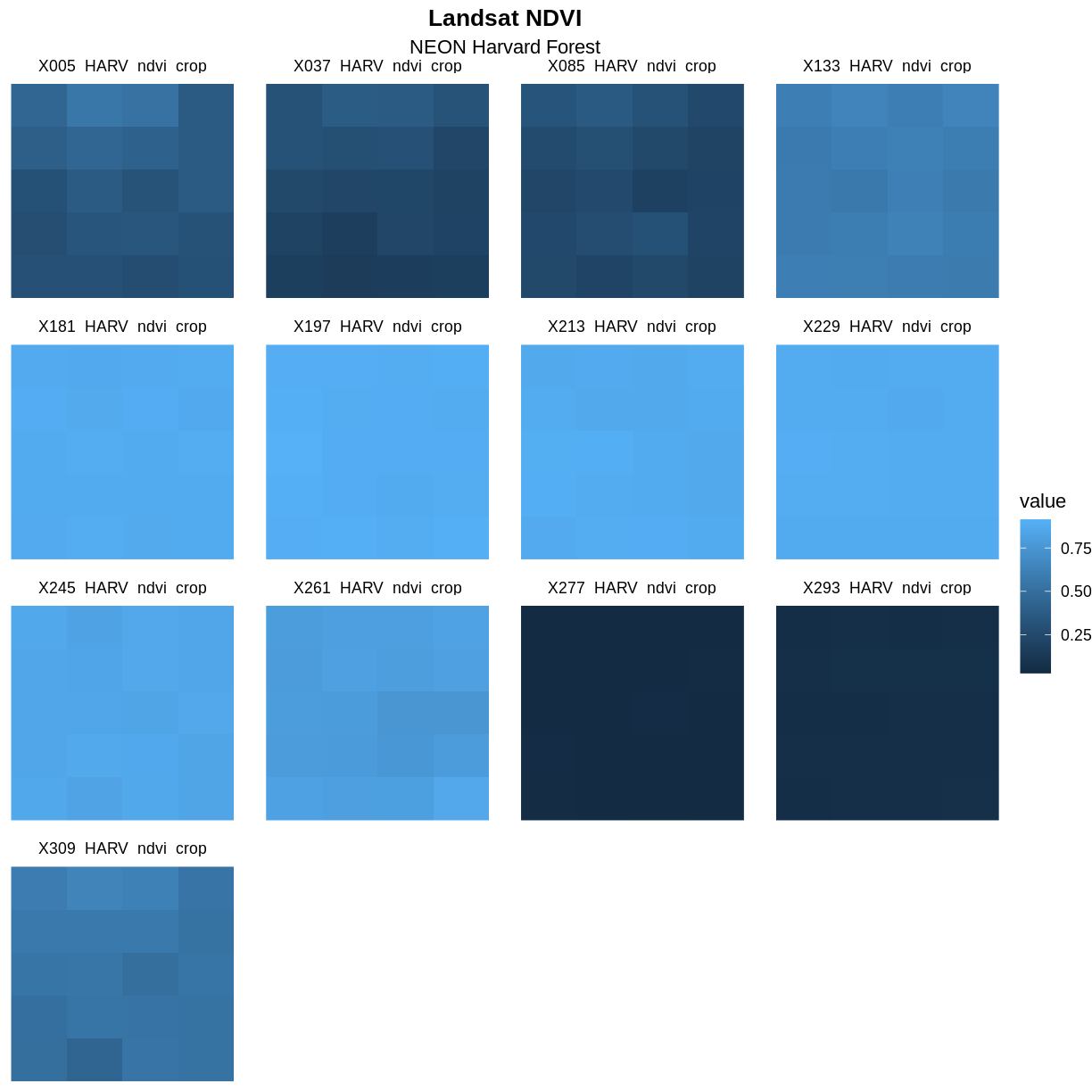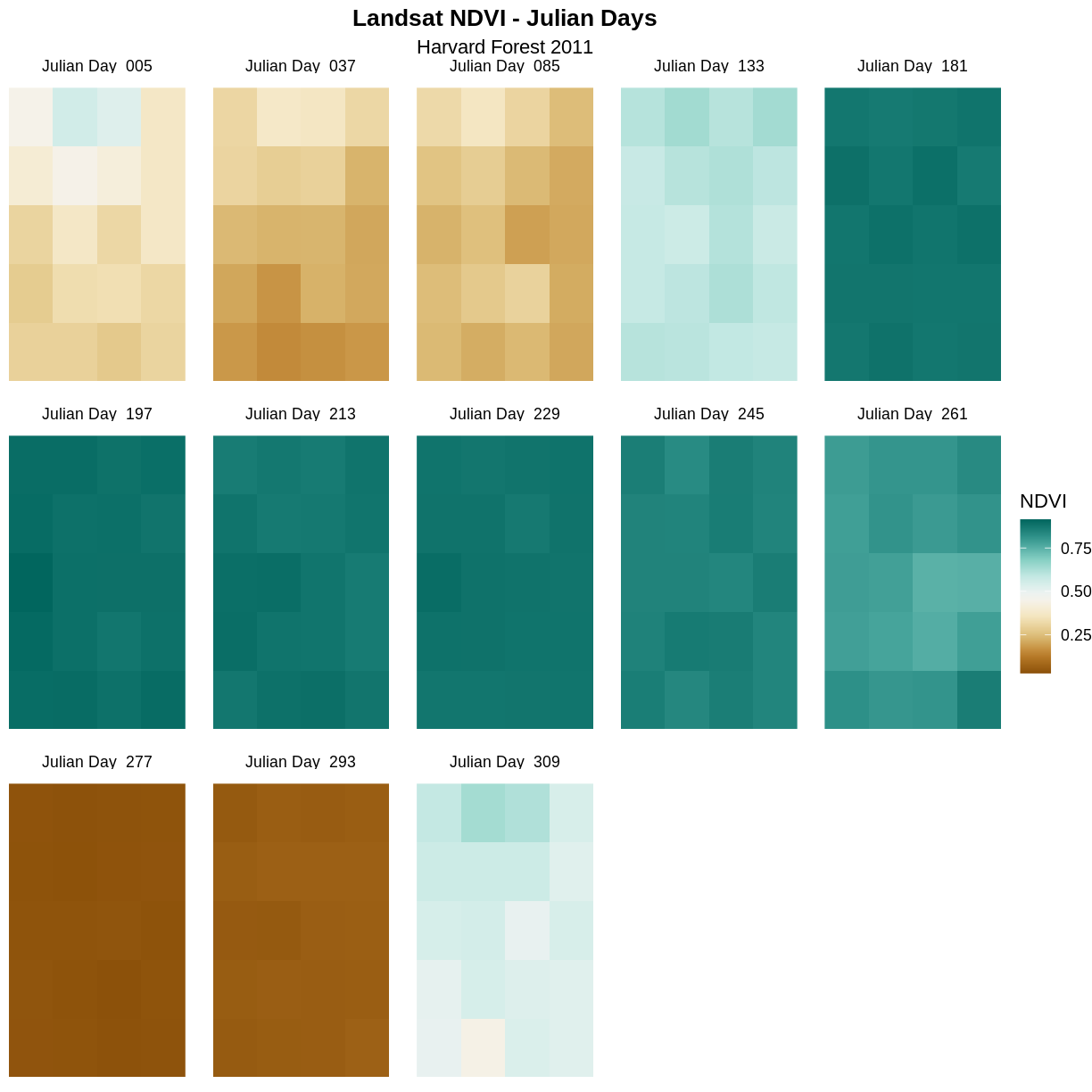Create Publication-quality Graphics
Overview
Teaching: 15 min
Exercises: 15 minQuestions
How can I create a publication-quality graphic and customize plot parameters?
Objectives
Assign custom names to bands in a RasterStack.
Customize raster plots using the
ggplot2package.
Warning in showSRID(SRS_string, format = "PROJ", multiline = "NO", prefer_proj =
prefer_proj): Discarded datum unknown in Proj4 definition
Warning in showSRID(SRS_string, format = "PROJ", multiline = "NO", prefer_proj =
prefer_proj): Discarded datum unknown in Proj4 definition
Warning in showSRID(SRS_string, format = "PROJ", multiline = "NO", prefer_proj =
prefer_proj): Discarded datum unknown in Proj4 definition
Warning in showSRID(SRS_string, format = "PROJ", multiline = "NO", prefer_proj =
prefer_proj): Discarded datum unknown in Proj4 definition
Warning in showSRID(SRS_string, format = "PROJ", multiline = "NO", prefer_proj =
prefer_proj): Discarded datum unknown in Proj4 definition
Warning in showSRID(SRS_string, format = "PROJ", multiline = "NO", prefer_proj =
prefer_proj): Discarded datum unknown in Proj4 definition
Warning in showSRID(SRS_string, format = "PROJ", multiline = "NO", prefer_proj =
prefer_proj): Discarded datum unknown in Proj4 definition
Warning in showSRID(SRS_string, format = "PROJ", multiline = "NO", prefer_proj =
prefer_proj): Discarded datum unknown in Proj4 definition
Warning in showSRID(SRS_string, format = "PROJ", multiline = "NO", prefer_proj =
prefer_proj): Discarded datum unknown in Proj4 definition
Warning in showSRID(SRS_string, format = "PROJ", multiline = "NO", prefer_proj =
prefer_proj): Discarded datum unknown in Proj4 definition
Warning in showSRID(SRS_string, format = "PROJ", multiline = "NO", prefer_proj =
prefer_proj): Discarded datum unknown in Proj4 definition
Warning in showSRID(SRS_string, format = "PROJ", multiline = "NO", prefer_proj =
prefer_proj): Discarded datum unknown in Proj4 definition
Warning in showSRID(SRS_string, format = "PROJ", multiline = "NO", prefer_proj =
prefer_proj): Discarded datum unknown in Proj4 definition
Warning in showSRID(SRS_string, format = "PROJ", multiline = "NO", prefer_proj =
prefer_proj): Discarded datum unknown in Proj4 definition
Things You’ll Need To Complete This Episode
See the lesson homepage for detailed information about the software, data, and other prerequisites you will need to work through the examples in this episode.
This episode covers how to customize your raster plots using the ggplot2 package
in R to create publication-quality plots.
Before and After
In the previous episode, we learned how to plot multi-band
raster data in R using the facet_wrap() function. This created a separate panel in our plot
for each raster band. The plot we created together is shown below:
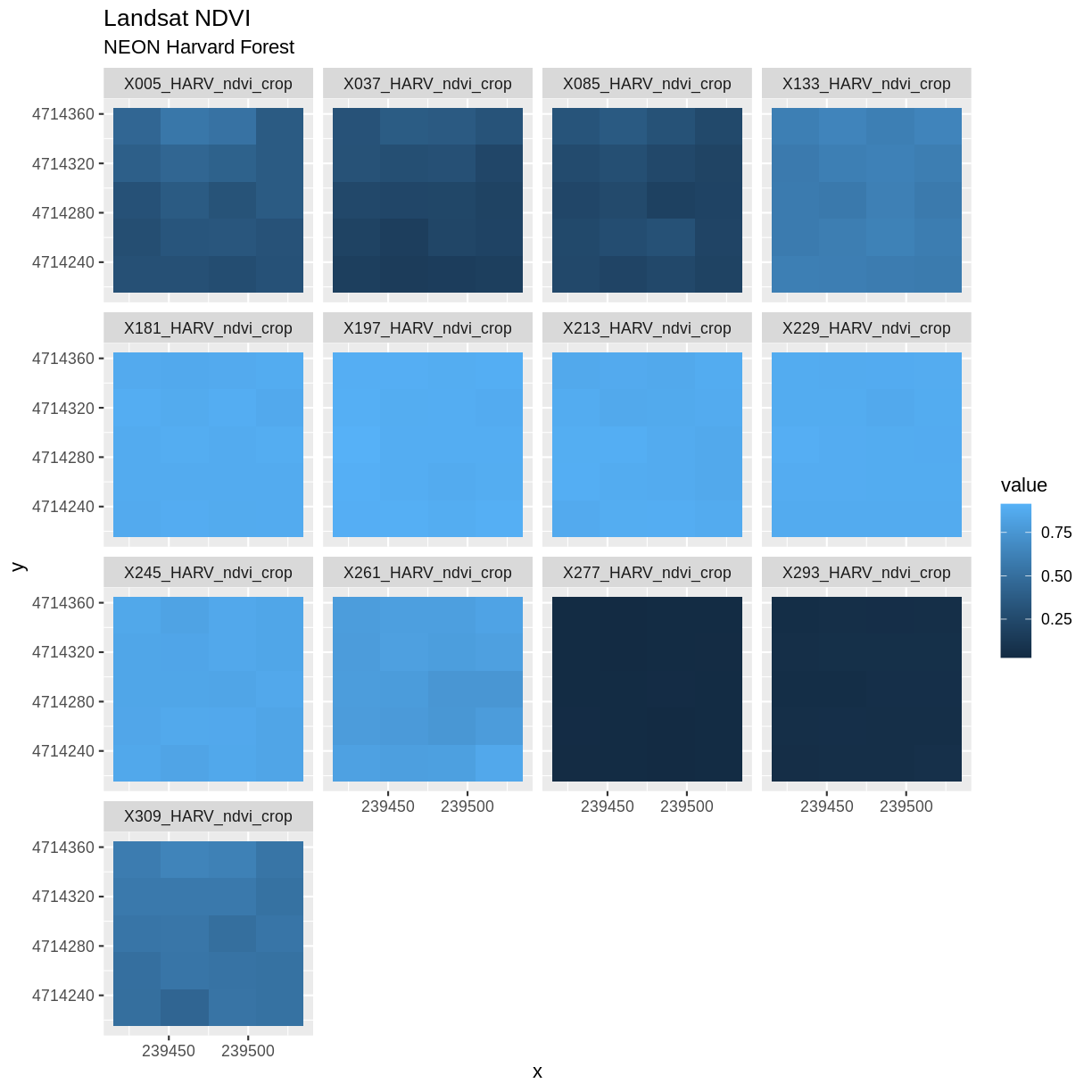
Although this plot is informative, it isn’t something we would expect to see in a journal publication. The x and y-axis labels aren’t informative. There is a lot of unnecessary gray background and the titles of each panel don’t clearly state that the number refers to the Julian day the data was collected. In this episode, we will customize this plot above to produce a publication quality graphic. We will go through these steps iteratively. When we’re done, we will have created the plot shown below.
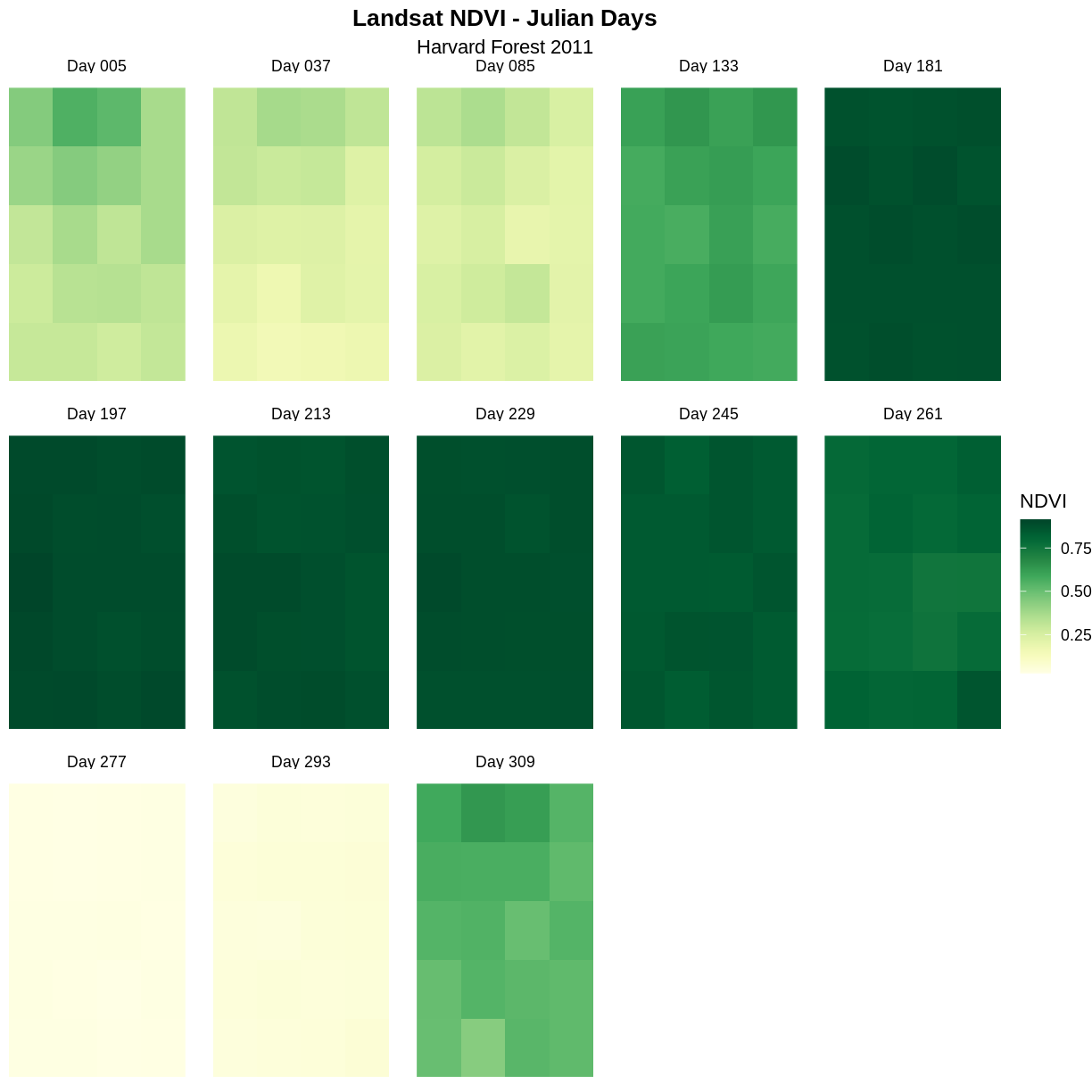
Adjust the Plot Theme
The first thing we will do to our plot remove the x and y-axis labels and axis ticks, as these are
unnecessary and make our plot look messy. We can do this by setting the plot theme to void.
ggplot() +
geom_raster(data = NDVI_HARV_stack_df , aes(x = x, y = y, fill = value)) +
facet_wrap(~variable) +
ggtitle("Landsat NDVI", subtitle = "NEON Harvard Forest") +
theme_void()
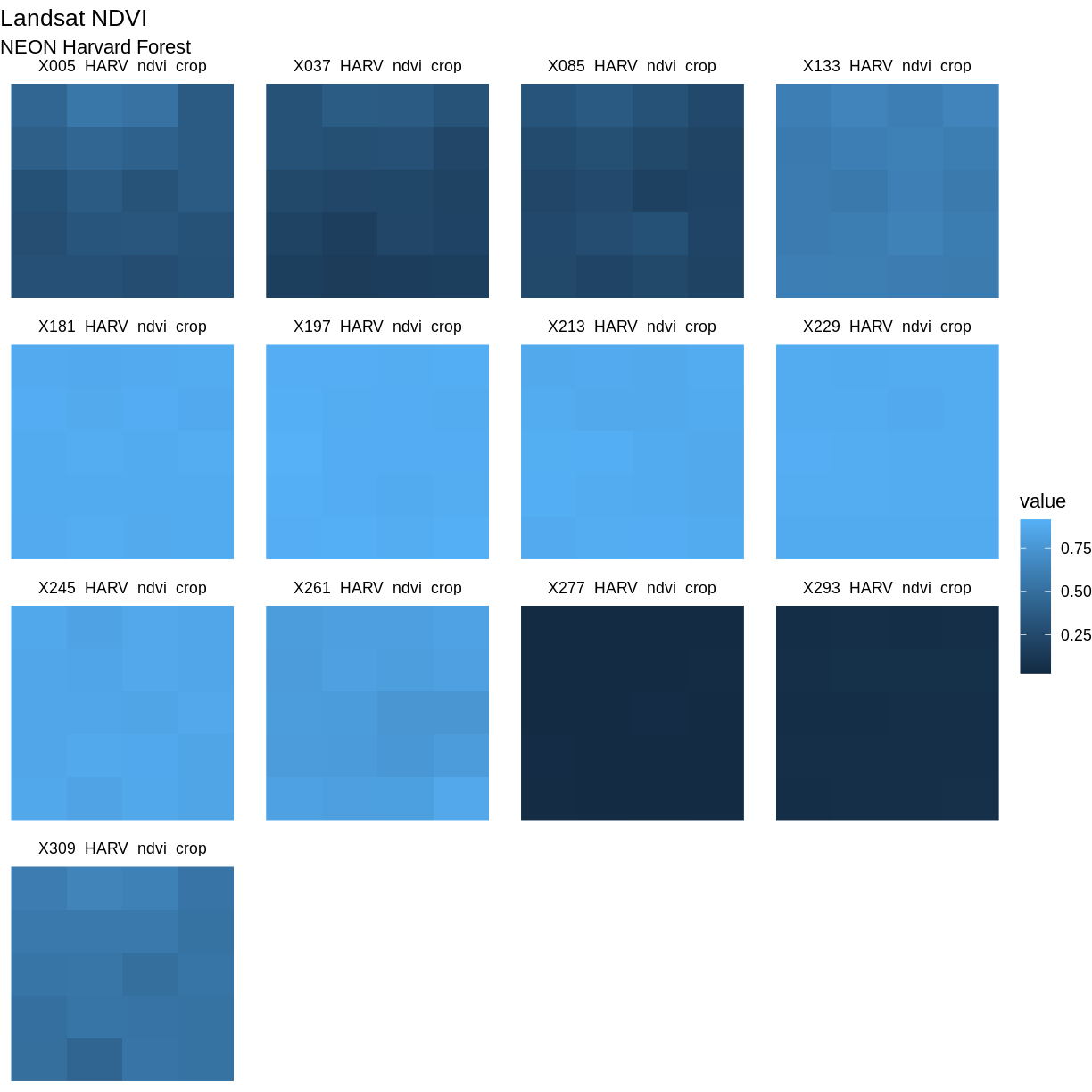
Next we will center our plot title and subtitle. We need to do this after the theme_void() layer,
because R interprets the ggplot layers in order. If we first tell R to center our plot title,
and then set the theme to void, any adjustments we’ve made to the plot theme will be over-written
by the theme_void() function. So first we make the theme void and then we center the title.
We center both the title and subtitle by using the theme() function and setting the hjust
parameter to 0.5. The hjust parameter stands for “horizontal justification” and takes any value between
0 and 1. A setting of 0 indicates left justification and a setting of 1 indicates right justification.
ggplot() +
geom_raster(data = NDVI_HARV_stack_df , aes(x = x, y = y, fill = value)) +
facet_wrap(~variable) +
ggtitle("Landsat NDVI", subtitle = "NEON Harvard Forest") +
theme_void() +
theme(plot.title = element_text(hjust = 0.5),
plot.subtitle = element_text(hjust = 0.5))
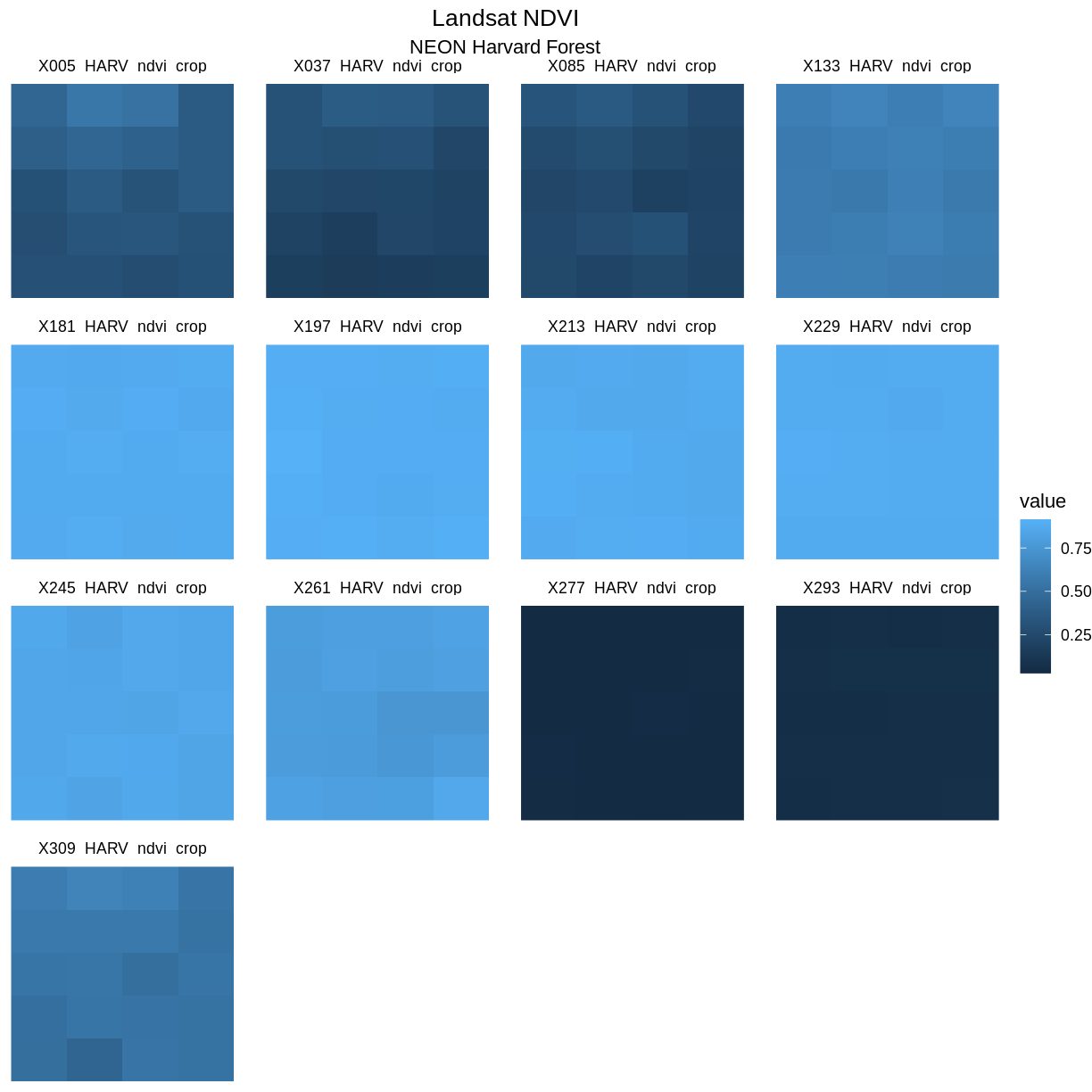
Challenge
Change the plot title (but not the subtitle) to bold font. You can (and should!) use the help menu in RStudio or any internet resources to figure out how to change this setting.
Answers
Adjust the Color Ramp
Next, let’s adjust the color ramp used to render the rasters. First, we can
change the blue color ramp to a green one that is more visually suited to our
NDVI (greenness) data using the colorRampPalette() function in combination
with colorBrewer which requires loading the RColorBrewer library. Then we use scale_fill_gradientn to pass the list of
colours (here 20 different colours) to ggplot.
First we need to create a set of colors to use. We will select a set of nine colors from the “YlGn” (yellow-green) color palette. This returns a set of hex color codes:
library(RColorBrewer)
brewer.pal(9, "YlGn")
[1] "#FFFFE5" "#F7FCB9" "#D9F0A3" "#ADDD8E" "#78C679" "#41AB5D" "#238443"
[8] "#006837" "#004529"
Then we will pass those color codes to the colorRampPalette function, which
will interpolate from those colors a more nuanced color range.
green_colors <- brewer.pal(9, "YlGn") %>%
colorRampPalette()
We can
tell the colorRampPalette() function how many discrete colors within this color range to
create. In our case, we will use 20 colors when we plot our graphic.
ggplot() +
geom_raster(data = NDVI_HARV_stack_df , aes(x = x, y = y, fill = value)) +
facet_wrap(~variable) +
ggtitle("Landsat NDVI", subtitle = "NEON Harvard Forest") +
theme_void() +
theme(plot.title = element_text(hjust = 0.5, face = "bold"),
plot.subtitle = element_text(hjust = 0.5)) +
scale_fill_gradientn(name = "NDVI", colours = green_colors(20))
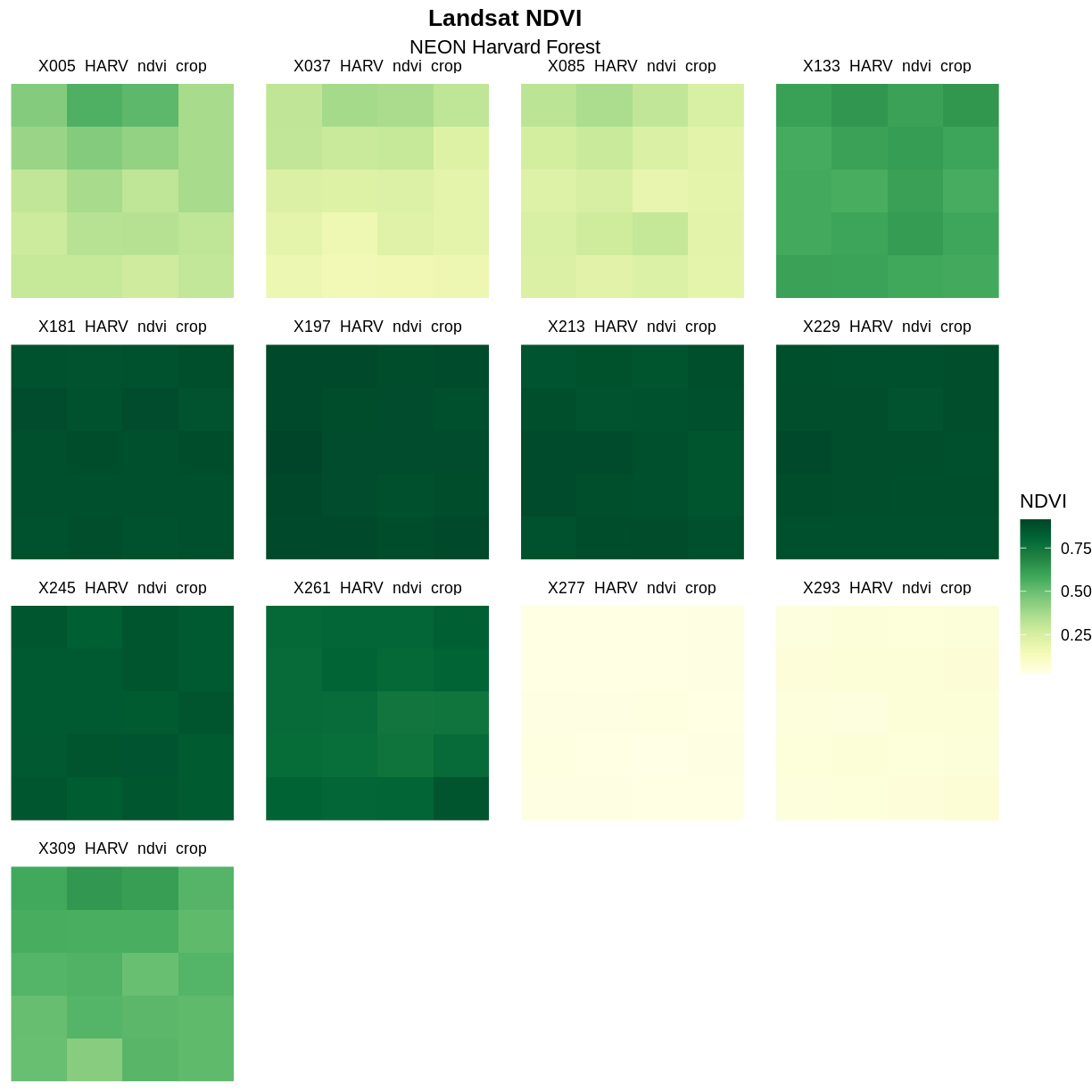
The yellow to green color ramp visually represents NDVI well given it’s a measure of greenness. Someone looking at the plot can quickly understand that pixels that are more green have a higher NDVI value.
Data Tip
For all of the
brewer.palramp names see the brewerpal page.
Data Tip
Cynthia Brewer, the creator of ColorBrewer, offers an online tool to help choose suitable color ramps, or to create your own. ColorBrewer 2.0; Color Advise for Cartography
Refine Plot & Tile Labels
Next, let’s label each panel in our plot with the Julian day that the
raster data for that panel was collected. The current names come from the band
“layer names”” stored in the
RasterStack and the first part of each name is the Julian day.
To create a more meaningful label we can remove the “x” and replace it with
“day” using the gsub() function in R. The syntax is as follows:
gsub("StringToReplace", "TextToReplaceIt", object).
First let’s remove “_HARV_NDVI_crop” from each label to make the labels
shorter and remove repetition. To illustrate how this works, we will first
look at the names for our NDVI_HARV_stack object:
names(NDVI_HARV_stack)
[1] "X005_HARV_ndvi_crop" "X037_HARV_ndvi_crop" "X085_HARV_ndvi_crop"
[4] "X133_HARV_ndvi_crop" "X181_HARV_ndvi_crop" "X197_HARV_ndvi_crop"
[7] "X213_HARV_ndvi_crop" "X229_HARV_ndvi_crop" "X245_HARV_ndvi_crop"
[10] "X261_HARV_ndvi_crop" "X277_HARV_ndvi_crop" "X293_HARV_ndvi_crop"
[13] "X309_HARV_ndvi_crop"
Now we will use the gsub() function to find the character string
“_HARV_ndvi_crop” and replace it with a blank string (“”). We will
assign this output to a new object (raster_names) and look
at that object to make sure our code is doing what we want it to.
raster_names <- names(NDVI_HARV_stack)
raster_names <- gsub("_HARV_ndvi_crop", "", raster_names)
raster_names
[1] "X005" "X037" "X085" "X133" "X181" "X197" "X213" "X229" "X245" "X261"
[11] "X277" "X293" "X309"
So far so good. Now we will use gsub() again to replace the “X” with the word
“Day” followed by a space.
raster_names <- gsub("X", "Day ", raster_names)
raster_names
[1] "Day 005" "Day 037" "Day 085" "Day 133" "Day 181" "Day 197" "Day 213"
[8] "Day 229" "Day 245" "Day 261" "Day 277" "Day 293" "Day 309"
Our labels look good now. Let’s reassign them to our all_NDVI_HARV object:
labels_names <- setNames(raster_names, unique(NDVI_HARV_stack_df$variable))
Once the names for each band have been reassigned, we can render our plot with
the new labels using alabeller.
ggplot() +
geom_raster(data = NDVI_HARV_stack_df , aes(x = x, y = y, fill = value)) +
facet_wrap(~variable, labeller = labeller(variable = labels_names)) +
ggtitle("Landsat NDVI", subtitle = "NEON Harvard Forest") +
theme_void() +
theme(plot.title = element_text(hjust = 0.5, face = "bold"),
plot.subtitle = element_text(hjust = 0.5)) +
scale_fill_gradientn(name = "NDVI", colours = green_colors(20))
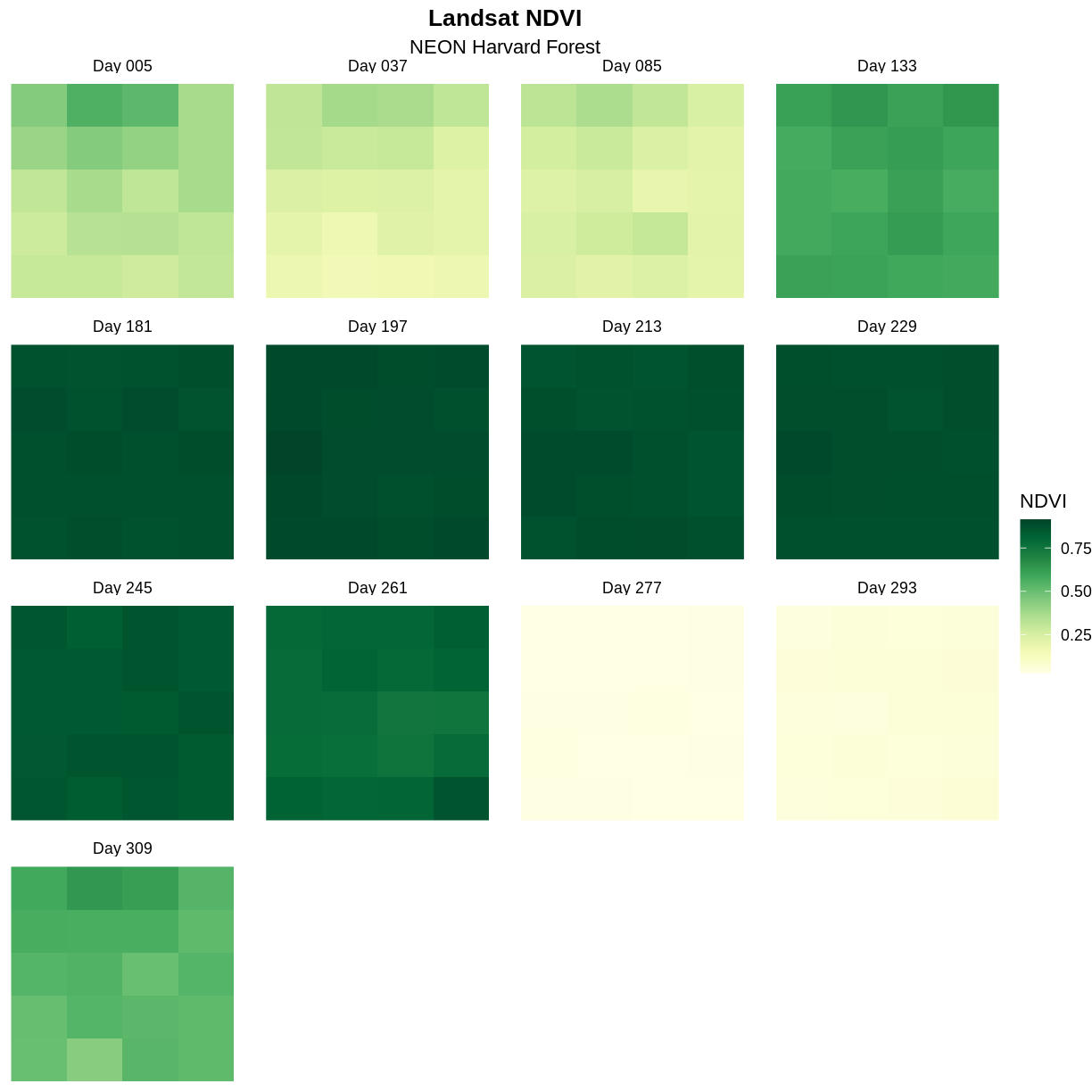
Change Layout of Panels
We can adjust the columns of our plot by setting the number of columns ncol
and the number of rows nrow in facet_wrap. Let’s make our plot so that
it has a width of five panels.
ggplot() +
geom_raster(data = NDVI_HARV_stack_df , aes(x = x, y = y, fill = value)) +
facet_wrap(~variable, ncol = 5, labeller = labeller(variable = labels_names)) +
ggtitle("Landsat NDVI", subtitle = "NEON Harvard Forest") +
theme_void() +
theme(plot.title = element_text(hjust = 0.5, face = "bold"),
plot.subtitle = element_text(hjust = 0.5)) +
scale_fill_gradientn(name = "NDVI", colours = green_colors(20))
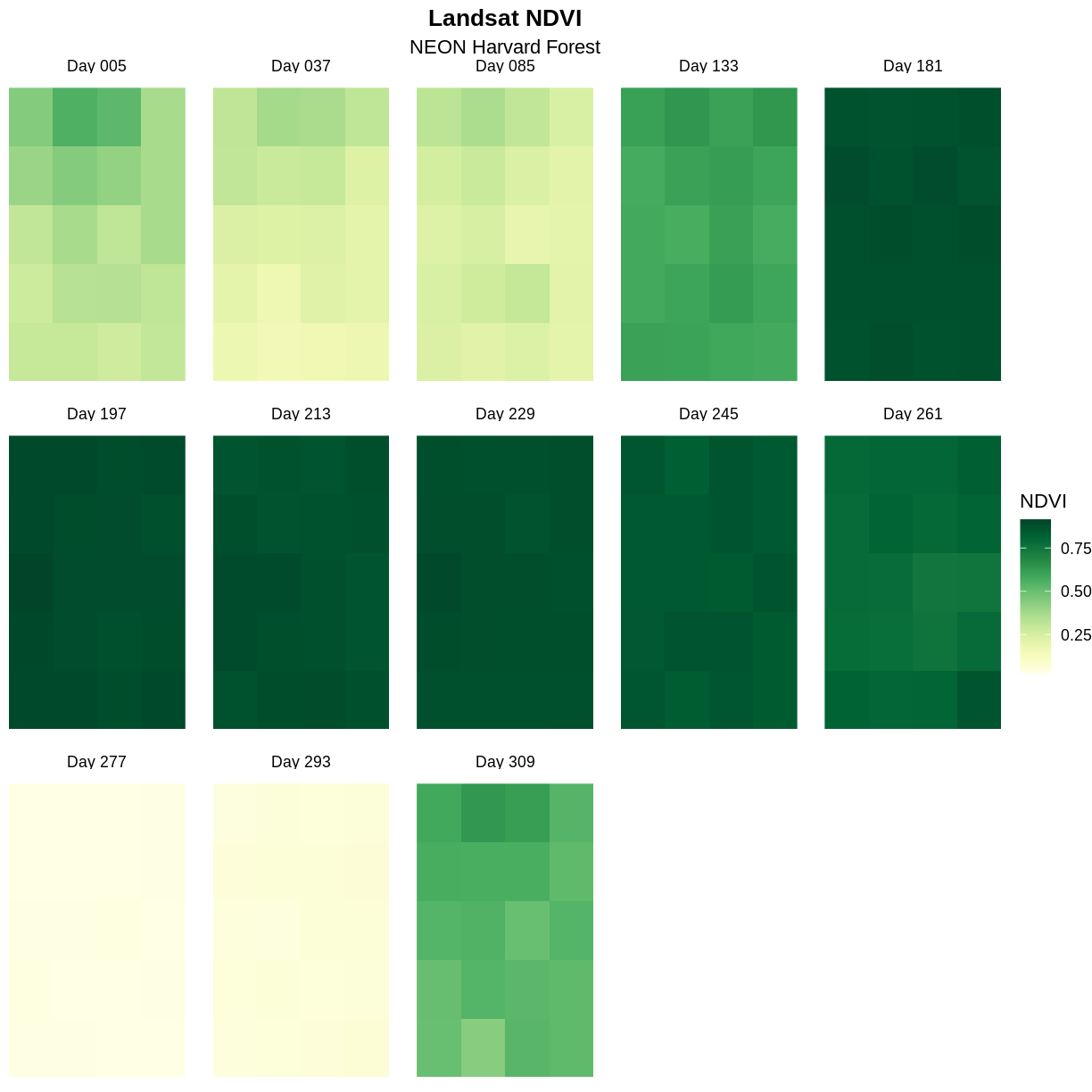
Now we have a beautiful, publication quality plot!
Challenge: Divergent Color Ramps
When we used the
gsub()function to modify the tile labels we replaced the beginning of each tile title with “Day”. A more descriptive name could be “Julian Day”. Update the plot above with the following changes:
- Label each tile “Julian Day” with the julian day value following.
- Change the color ramp to a divergent brown to green color ramp.
Questions: Does having a divergent color ramp represent the data better than a sequential color ramp (like “YlGn”)? Can you think of other data sets where a divergent color ramp may be best?
Answers
Key Points
Use the
theme_void()function for a clean background to your plot.Use the
element_text()function to adjust text size, font, and position.Use the
brewer.pal()function to create a custom color palette.Use the
gsub()function to do pattern matching and replacement in text.
